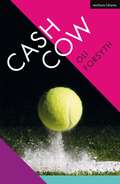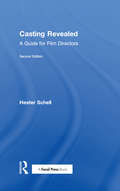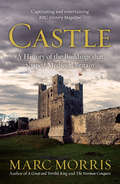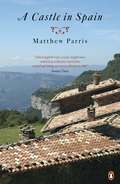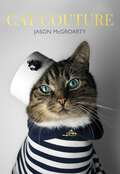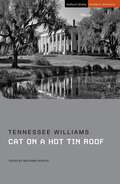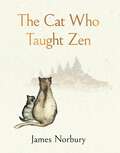- Table View
- List View
Cash Cow (Modern Plays)
by Oli ForsythJust tennis all day, whenever you want. Not many 13 year olds have that, do they? They're going to make you so good we won't recognise you. Creating a tennis champion costs a lot; it requires time, dedication and, most importantly, cash. Nina and Ade decide early on that their daughter is worth the investment. Imagine the return - prize money, world travel, endorsements and maybe their own tennis academy. Hell-bent on their child becoming Britain's number 1, the pair are willing to sacrifice just about anything. If you want to reach the top spot in the game of tennis, love means nothing…Oli Forsyth's breakthrough play is a blistering exploration of blind, parental ambition and the consequences of tough love.
Cassavetes Directs: John Cassavetes And The Making Of Love Streams
by Michael VenturaIn 1983 visionary director John Cassavetes asked journalist Michael Ventura to write a unique film study -- an on-set diary of the making of his film Love Streams. Cassavetes laid out his expectations. He wanted 'a daring book, a tough book'. In Ventura's words, 'All I had to do for 'daring' and 'tough' was transcribe this man's audacity day by day.' Cassavetes Directs describes the creation of Love Streams shot by shot, crisis by crisis. During production, the director learned that he was seriously ill, that this film might, as it tragically turned out, be his last. Starring alongside actress and wife Gena Rowlands, Cassavetes shot in sequence, reconceiving and revising his film almost nightly, in order that Love Streams could stand as his final statement. Both an intimate portrait of the man and an insight into his unique filmmaking philosophy, Cassavetes Directs documents a heroic moment in the life of a great artist.
Cast On, Bind Off: 54 Step-by-Step Methods; Find the perfect start and finish for every knitting project
by Leslie Ann BestorThis one-of-a-kind reference guide presents more than 50 techniques for creating the perfect edge for any knitting project.
Casting a Movement: The Welcome Table Initiative
by Claire Syler Daniel BanksCasting a Movement brings together US-based actors, directors, educators, playwrights, and scholars to explore the cultural politics of casting. Drawing on the notion of a "welcome table"—a space where artists of all backgrounds can come together as equals to create theatre—the book’s contributors discuss casting practices as they relate to varying communities and contexts, including Middle Eastern American theatre, disability culture, multilingual performance, Native American theatre, color- and culturally-conscious casting, and casting as a means to dismantle stereotypes. Syler and Banks suggest that casting is a way to invite more people to the table so that the full breadth of US identities can be reflected onstage, and that casting is inherently a political act; because an actor’s embodied presence both communicates a dramatic narrative and evokes cultural assumptions associated with appearance, skin color, gender, sexuality, and ability, casting choices are never neutral. By bringing together a variety of artistic perspectives to discuss common goals and particular concerns related to casting, this volume features the insights and experiences of a broad range of practitioners and experts across the field. As a resource-driven text suitable for both practitioners and academics, Casting a Movement seeks to frame and mobilize a social movement focused on casting, access, and representation.
Casting a Movement: The Welcome Table Initiative
by Claire Syler Daniel BanksCasting a Movement brings together US-based actors, directors, educators, playwrights, and scholars to explore the cultural politics of casting. Drawing on the notion of a "welcome table"—a space where artists of all backgrounds can come together as equals to create theatre—the book’s contributors discuss casting practices as they relate to varying communities and contexts, including Middle Eastern American theatre, disability culture, multilingual performance, Native American theatre, color- and culturally-conscious casting, and casting as a means to dismantle stereotypes. Syler and Banks suggest that casting is a way to invite more people to the table so that the full breadth of US identities can be reflected onstage, and that casting is inherently a political act; because an actor’s embodied presence both communicates a dramatic narrative and evokes cultural assumptions associated with appearance, skin color, gender, sexuality, and ability, casting choices are never neutral. By bringing together a variety of artistic perspectives to discuss common goals and particular concerns related to casting, this volume features the insights and experiences of a broad range of practitioners and experts across the field. As a resource-driven text suitable for both practitioners and academics, Casting a Movement seeks to frame and mobilize a social movement focused on casting, access, and representation.
The Casting Handbook: For Film and Theatre Makers
by Suzy Catliff Jennifer GranvilleCasting is a crucial creative element of any production - and yet the craft and skills needed to put together a successful and exciting cast are often overlooked. The Casting Handbook explains the casting process from beginning to end and covers everything producers and directors needs to know – as well as proving a fascinating and illuminating read for actors. The book explores: how to prepare a breakdown where to source actors how to prepare for a casting session how to make casting decisions how a cast is put together how deals are done ethics and the law, with special reference to casting children how a casting director contributes to the initial development of the script how the casting works from fringe theatre to Hollywood blockbusters The Casting Handbook considers actors’, producers’, agents’ and directors’ relationship with a casting director, the day to day work that is casting, and how approaching it in a professional and informed manner can make the difference to the final product. Including interviews with actors, agents, directors, casting directors and producers; case studies; exercises; and a fact file of useful templates and contacts, this book offers a thorough induction into the casting process, suitable for students and early career professionals in any media.
The Casting Handbook: For Film and Theatre Makers
by Suzy Catliff Jennifer GranvilleCasting is a crucial creative element of any production - and yet the craft and skills needed to put together a successful and exciting cast are often overlooked. The Casting Handbook explains the casting process from beginning to end and covers everything producers and directors needs to know – as well as proving a fascinating and illuminating read for actors. The book explores: how to prepare a breakdown where to source actors how to prepare for a casting session how to make casting decisions how a cast is put together how deals are done ethics and the law, with special reference to casting children how a casting director contributes to the initial development of the script how the casting works from fringe theatre to Hollywood blockbusters The Casting Handbook considers actors’, producers’, agents’ and directors’ relationship with a casting director, the day to day work that is casting, and how approaching it in a professional and informed manner can make the difference to the final product. Including interviews with actors, agents, directors, casting directors and producers; case studies; exercises; and a fact file of useful templates and contacts, this book offers a thorough induction into the casting process, suitable for students and early career professionals in any media.
Casting Revealed: A Guide for Film Directors
by Hester SchellCasting is an essential component of any film or video project, but the core skill-set needed to cast effectively is little understood. Casting Revealed: A Guide for Film Directors is a straightforward manual on the art and craft of casting. Here, director Hester Schell offers her insider perspective on casting workflows, industry standards, finding actors, running auditions, what to look for in a performance, contracts, and making offers. This new edition has been updated with fresh interviews with casting directors, full color head shots, new information about online video submissions, and a companion website featuring forms, contracts, and sample scenes for auditions. Gain a fuller understanding of the misunderstood art and craft of casting actors for film and video production. Learn to find the right actors for any production, run auditions, interview actors, effectively judge performances and video submissions, evaluate suitability for a role, discover what it is you need from an actor, view headshots, draft contracts, make offers, and navigate current industry standards, unions, and procedures. This new edition has been updated to include full color sample head shots, new content on online video submissions, listings of casting wesbites, film resources, and film commissions and a companion website featuring interviews with celebrated casting directors from New York, Portland, Boston and Austin, necessary forms, sign-in sheets, contracts, and sample scenes for auditions.
Casting Revealed: A Guide for Film Directors
by Hester SchellCasting is an essential component of any film or video project, but the core skill-set needed to cast effectively is little understood. Casting Revealed: A Guide for Film Directors is a straightforward manual on the art and craft of casting. Here, director Hester Schell offers her insider perspective on casting workflows, industry standards, finding actors, running auditions, what to look for in a performance, contracts, and making offers. This new edition has been updated with fresh interviews with casting directors, full color head shots, new information about online video submissions, and a companion website featuring forms, contracts, and sample scenes for auditions. Gain a fuller understanding of the misunderstood art and craft of casting actors for film and video production. Learn to find the right actors for any production, run auditions, interview actors, effectively judge performances and video submissions, evaluate suitability for a role, discover what it is you need from an actor, view headshots, draft contracts, make offers, and navigate current industry standards, unions, and procedures. This new edition has been updated to include full color sample head shots, new content on online video submissions, listings of casting wesbites, film resources, and film commissions and a companion website featuring interviews with celebrated casting directors from New York, Portland, Boston and Austin, necessary forms, sign-in sheets, contracts, and sample scenes for auditions.
Casting the Parthenon Sculptures from the Eighteenth Century to the Digital Age
by Emma M. PayneThrough the 19th century, as archaeology started to emerge as a systematic discipline, plaster casting became a widely-adopted technique, newly applied by archaeologists to document and transmit discoveries from their expeditions. The Parthenon sculptures were some of the first to be cast. In the late 18th century and the first years of the 19th century, the French artist Fauvel and Lord Elgin's men conducted campaigns on the Athenian Acropolis. Both created casts of parts of the Parthenon sculptures that they did not remove and these were sent back to France and Britain where they were esteemed and displayed alongside other, original sections. Henceforth, casting was established as an essential archaeological tool and grew exponentially over the course of the century.Such casts are now not only fascinating historical objects but may also be considered time capsules, capturing the details of important ancient works when they were first moulded in centuries past. This book examines the role of 19th century casts as an archaeological resource and explores how their materiality and spread impacted the reception of the Parthenon sculptures and other Greek and Roman works. Investigation of their historical context is combined with analysis of new digital models of the Parthenon sculptures and their casts. Sensitive 3D imaging techniques allow investigation of the surface markings of the objects in exceptionally fine detail and enable quantitative comparative studies comparing the originals and the casts. The 19th century casts are found to be even more accurate, but also complex, than anticipated; through careful study of their multiple layers, we can retrieve surface information now lost from the originals through weathering and vandalism.
Casting the Parthenon Sculptures from the Eighteenth Century to the Digital Age
by Emma M. PayneThrough the 19th century, as archaeology started to emerge as a systematic discipline, plaster casting became a widely-adopted technique, newly applied by archaeologists to document and transmit discoveries from their expeditions. The Parthenon sculptures were some of the first to be cast. In the late 18th century and the first years of the 19th century, the French artist Fauvel and Lord Elgin's men conducted campaigns on the Athenian Acropolis. Both created casts of parts of the Parthenon sculptures that they did not remove and these were sent back to France and Britain where they were esteemed and displayed alongside other, original sections. Henceforth, casting was established as an essential archaeological tool and grew exponentially over the course of the century.Such casts are now not only fascinating historical objects but may also be considered time capsules, capturing the details of important ancient works when they were first moulded in centuries past. This book examines the role of 19th century casts as an archaeological resource and explores how their materiality and spread impacted the reception of the Parthenon sculptures and other Greek and Roman works. Investigation of their historical context is combined with analysis of new digital models of the Parthenon sculptures and their casts. Sensitive 3D imaging techniques allow investigation of the surface markings of the objects in exceptionally fine detail and enable quantitative comparative studies comparing the originals and the casts. The 19th century casts are found to be even more accurate, but also complex, than anticipated; through careful study of their multiple layers, we can retrieve surface information now lost from the originals through weathering and vandalism.
The Castle: A History
by John GoodallA vibrant history of the castle in Britain, from the early Middle Ages to the present day The castle has long had a pivotal place in British life, associated with lordship, landholding, and military might, and today it remains a powerful symbol of history. But castles have never been merely impressive fortresses—they were hubs of life, activity, and imagination. John Goodall weaves together the history of the British castle across the span of a millennium, from the eleventh to the twenty-first century, through the voices of those who witnessed it. Drawing on chronicles, poems, letters, and novels, including the work of figures like Gawain Poet, Walter Scott, Evelyn Waugh, and P. G. Wodehouse, Goodall explores the importance of the castle in our culture and society. From the medieval period to Civil War engagements, right up to modern manifestations in Harry Potter, Goodall reveals that the castle has always been put to different uses, and to this day continues to serve as a source of inspiration.
Castle: A History of the Buildings that Shaped Medieval Britain (Paper Toy Ser.)
by Marc MorrisBeginning with their introduction in the eleventh century, and ending with their widespread abandonment in the seventeenth, Marc Morris explores many of the country’s most famous castles, as well as some spectacular lesser-known examples. At times this is an epic tale, driven by characters like William the Conqueror, King John and Edward I, full of sieges and conquest on an awesome scale. But it is also by turns an intimate story of less eminent individuals, whose adventures, struggles and ambitions were reflected in the fortified residences they constructed. Be it ever so grand or ever so humble, a castle was first and foremost a home.To understand castles – who built them, who lived in them, and why – is to understand the forces that shaped medieval Britain.
A Castle in Spain
by Matthew Parris'Stands apart... This Englishman's castle might have started as a dream, but it has ended up being an extraordinary reality' Sunday TimesWalking in the Pyrenees one spring morning Matthew Parris stumbled upon a magnificent ruined mansion standing on the edge of a line of huge cliffs. Later he was to discover that parts of the house dated back to the 14th century though it had not been completed until 1559; and that it had survived two massive earthquakes before falling into disrepair in the early 1960s. A few years later, seduced by 'one of those foolish challenges that grip us in middle life', Parris bought the house, L'Avenc, and set about restoring it to its full glory. This delightful book chronicles it all: the original discovery, the attempts to discover its history, and then the long effortful years trying to bring it back to life in the face of scepticism from family, friends and Spanish neighbours. The original edition of A Castle in Spain was published in 2005 when the renovations were a work in progress; this new edition triumphantly records all that has happened since.
The Castle on Sunset: Love, Fame, Death and Scandal at Hollywood’s Chateau Marmont
by Shawn Levy'A must-read for anyone interested in the rich and racy history of Tinseltown' Cheryl Strayed, author of Wild'I want to live inside this book!' Taylor Jenkins Reid, author of Daisy Jones & The SixFor nearly ninety years, Hollywood's brightest stars have favoured the Chateau Marmont as a home away from home. It is a place filled with deep secrets but is hidden in plain sight, and its evolution parallels the growth of Hollywood itself. Perched above the Sunset Strip like a fairy-tale castle, the Chateau seems to come from another world entirely. An apartment-house-turned-hotel, it has been the backdrop for generations of gossip and folklore: 1930s bombshell Jean Harlow took lovers during her third honeymoon there; director Nicholas Ray slept with his sixteen-year-old Rebel Without a Cause star Natalie Wood; Anthony Perkins and Tab Hunter met poolside and began a secret affair; Jim Morrison swung from the balconies, once nearly falling to his death; John Belushi suffered a fatal overdose in a private bungalow; Lindsay Lohan got the boot after racking up nearly $50,000 in charges in less than two months. Much of what's happened inside the Chateau's walls has eluded the public eye - until now. With wit and prowess, Shawn Levy recounts the wild parties and scandalous liaisons, creative breakthroughs and marital breakdowns, births and untimely deaths that the Chateau Marmont has given rise to. Vivid, salacious and richly informed, the book is a glittering tribute to Hollywood as seen from the suites and bungalows of its most hallowed hotel.
Castles: Their Construction and History (Dover Architecture)
by Sidney ToyThe art of fortification had reached a high state of development even at the dawn of history. Powerful military works, dating from the remotest periods, have been found in Asia Minor, in Greece, and in the basins of the Tigris, the Euphrates, and the Nile rivers. The medieval castle, with its strategic, crenellated ramparts and aura of legend and romance, represents perhaps the most familiar form of a long-crucial art. This concise, scholarly volume traces the history of the castle from its ancient roots in the Levant, through Roman times and the Middle Ages, to the fanciful chateaux of the sixteenth century. Profusely illustrated with nearly 200 photographs, floor-plan diagrams, and pen-and-ink renderings, Castles explores innovations in castle design, siege operations, artillery, and other weapons, living conditions within the castle, and clearly explains intriguing features of construction: moats, baileys, keeps, donjons, barbicans, double curtains, loopholes, and many others. In addition, noted historian and fortification expert Sidney Toy takes the reader on a detailed guided tour of over 120 of the most famous castles and fortresses of Europe and the Middle East. Explore Caernarvon Castle (associated with the Princes of Wales), Dover Castle, Arundel Castle, Hadrian's Wall, the Tower of London, the famed city of Troy, and dozens of others in vivid accounts focusing on the architecture, offensive and defensive modifications, and historical importance of each structure or site. Castle enthusiasts, medievalists, military buffs, travelers, and anyone interested in the evolution and development of the castle will find this meticulously researched overview an informative and absorbing account.
The Castles on the Ground: The Anatomy of Suburbia
by J. M. Richards'There is the puzzle which it is the purpose of this book to try to elucidate. On the one hand, we have the alleged deficiencies of suburban taste; on the other we have the appeal it holds for ninety out of a hundred Englishmen, an appeal which cannot be explained away as some strange instance of mass aberration...'Sir James Richards (1907-1992), editor of the Architectural Review for 34 years, was arguably the leading advocate in Britain for the modern movement in architecture. The Castles on the Ground (1946) constitutes Richards' argument for and appreciation of the virtues of the built environment and the architectural aesthetic of suburbia. Concise and elegantly phrased, the volume is further blessed with superb illustrations by John Piper.
Castles (Usborne Beginners)
by Stephanie Turnbullho lived in a castle, and what was it like? This book lays out the answers and explores the history of castles, knights and battles using photographs, clear step-by-step illustrations and simple, straightforward text.
Cat Couture
by Jason McGroartyA series of portraits of feline fashionista Hummus taken by her owner, professional photographer Jason McGroarty. Hummus was diagnosed with Feline Leukaemia when she was a kitten and is unable to play outside with other cats. However, Hummus is a total fashion diva and likes to model new looks in her own personal cat-sized studio. In these unique, full-colour portraits Jason channels the quirky and sassy personality of this extremely well-dressed and stylish cat.
Cat Knits: 16 pawsome knitting patterns for yarn and cat lovers
by Marna GilliganThis is the ultimate cat lover's collection of knitting patterns for garments and accessories. If you love cats and yarn you will want this collection of 16 quirky designs all based around the theme of cats. It includes four garments graded for 16 different sizes, as well as cat-themed accessories including a wrap, shawl, scarf, cowl, capelet, mittens and hats. The patterns are divided up into four chapters, each with a different style of cat-themed design similar to Marna's Sinister Catdigan pattern.
Cat on a Hot Tin Roof (Student Editions)
by Tennessee Williams'Williams's favourite among his plays, [Cat on a Hot Tin Roof] is perhaps his most impassioned and articulate statement on human isolation, the wrenching problems of communication between people and the ways in which death defines life.' NEW YORK TIMESIn Cat on a Hot Tin Roof, a Southern family meet to celebrate 'Big Daddy' Pollitt's 65th birthday. But as the party unfolds, the facade of a happy family gathering is fractured by sexual frustration, repressed love and greed in the light of their father's impending death. This edition includes a commentary by Benjamin Hudson, which explores the major themes of the play, including illness and mortality; white supremacy through the plantation setting; mendacity and 'fake news'; alcoholism and addiction; as well as sexuality, womanhood and mid-century notions of masculinity. It draws attention to the context of the play, including the cultural, social and political landscape of the Mississippi Delta and St. Louis; the first-hand witnessing of Black life in the South; homosexuality and outsider sympathy; and American conservatism and the idealised 1950s family. It also delves into recent productions and adaptations of the play, including the Bollywood and Antoine Fuqua film adaptations.
Cat on a Hot Tin Roof (Student Editions)
by Tennessee Williams'Williams's favourite among his plays, [Cat on a Hot Tin Roof] is perhaps his most impassioned and articulate statement on human isolation, the wrenching problems of communication between people and the ways in which death defines life.' NEW YORK TIMESIn Cat on a Hot Tin Roof, a Southern family meet to celebrate 'Big Daddy' Pollitt's 65th birthday. But as the party unfolds, the facade of a happy family gathering is fractured by sexual frustration, repressed love and greed in the light of their father's impending death. This edition includes a commentary by Benjamin Hudson, which explores the major themes of the play, including illness and mortality; white supremacy through the plantation setting; mendacity and 'fake news'; alcoholism and addiction; as well as sexuality, womanhood and mid-century notions of masculinity. It draws attention to the context of the play, including the cultural, social and political landscape of the Mississippi Delta and St. Louis; the first-hand witnessing of Black life in the South; homosexuality and outsider sympathy; and American conservatism and the idealised 1950s family. It also delves into recent productions and adaptations of the play, including the Bollywood and Antoine Fuqua film adaptations.
Cat People (BFI Film Classics)
by Kim NewmanNovelist and critic Kim Newman assesses the horror noir Cat People (1943), produced by Val Lewton and directed by Jacques Tourneur. This important and influential film is considered in the light of its place in film history and as a work of ambitious horror. The new edition includes a postscript about the sequel, The Curse of the Cat People.
Cat People (BFI Film Classics)
by Kim NewmanNovelist and critic Kim Newman assesses the horror noir Cat People (1943), produced by Val Lewton and directed by Jacques Tourneur. This important and influential film is considered in the light of its place in film history and as a work of ambitious horror. The new edition includes a postscript about the sequel, The Curse of the Cat People.
The Cat Who Taught Zen: The beautifully illustrated new tale from the bestselling author of Big Panda and Tiny Dragon
by James NorburyTHE BIG PANDA AND TINY DRAGON AUTHOR AND ILLUSTRATOR JAMES NORBURY TELLS THE STORY OF THE CAT WHO LEARNED HOW TO BE MORE ZEN . . ."I've learnt that what we want is seldom what we need, and what we need is almost never what we want"This is the tale of a cat wise in the ways of zen, journeying to discover a fabled ancient pine, under which infinite wisdom may be found.Along the way he meets a vivid cast of animals: from an anxious monkey and a tortoise tired of life, to a tiger struggling with anger, a confused wolf cub and a covetous crow.But it's a surprise encounter with a playful kitten, that forces the cat to question everything . . .Told in a gentle, calming style, The Cat Who Taught Zen introduces a new cast of characters for readers of all ages to fall in love with, offering timeless wisdom wrapped up into a tale of beguiling beauty.__________Big Panda and Tiny Dragon, Sunday Times bestseller, July 2022
